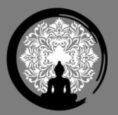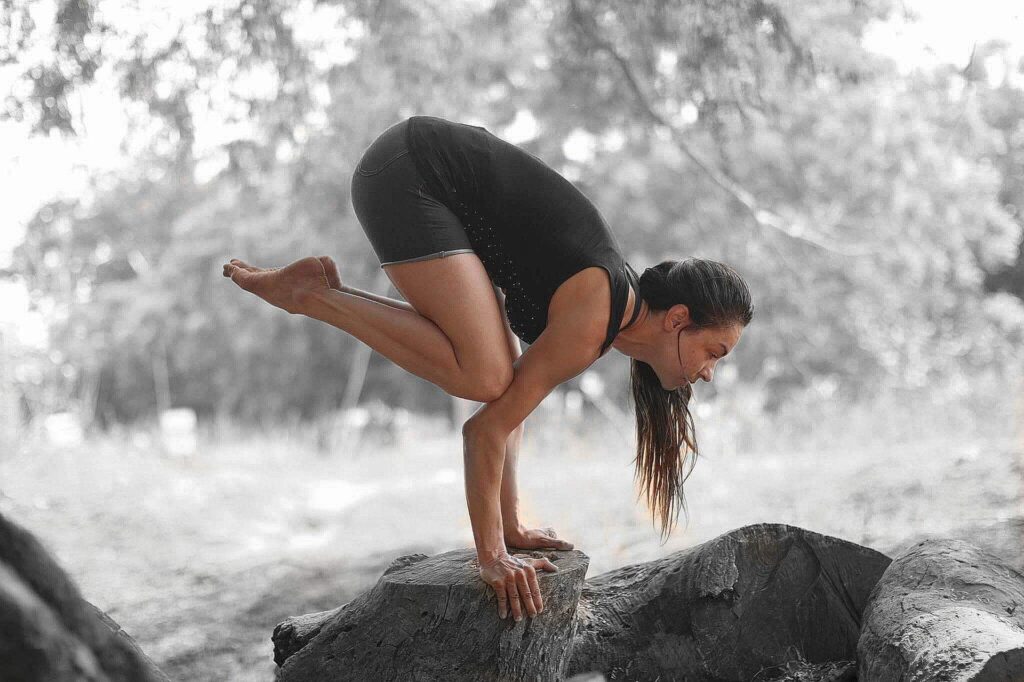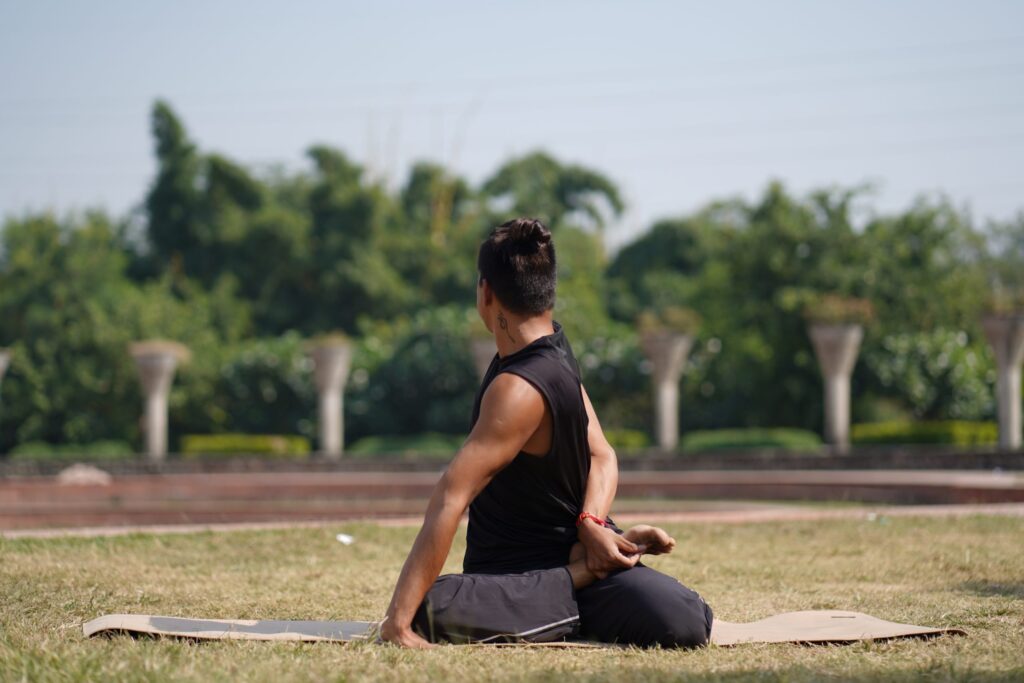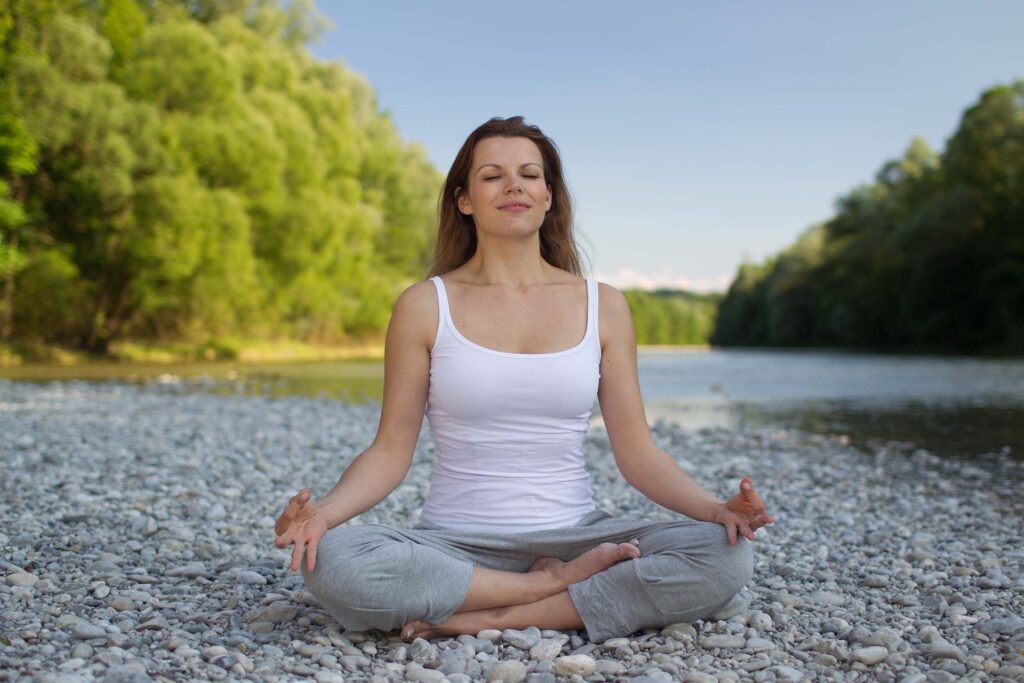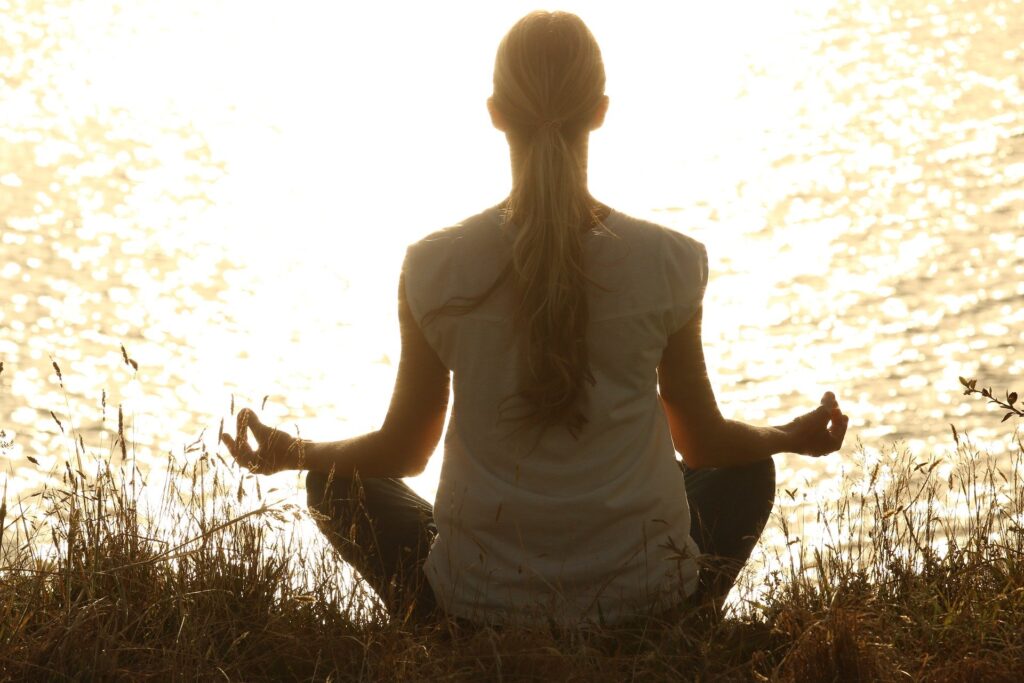Kakasana ( काकासन ) is also known as Crow pose. This asana not only helps to strengthen arms, wrists and shoulders but also develops coordination, balance and flexibility of your body. This Hatha Yoga pose, enables a person to overcome weaknesses and face any challenge of life. Here, we’ll talk about various such benefits, steps & precautions for performing Kakasana.
The Sanskrit word ‘Kakasana’ ( काकासन ) is the combination of two words – ‘Kaka’ ( काक ) means ‘Crow‘ and Asana ( आसन ) means ‘seat‘ or ‘pose’. In this pose, hands of a yogi looks similar to a crow’s feet and bend elbows appears a crow’s knees. Plus, thighs are folded up in such a way that knees are tucked against the uplifted arms, supporting body’s weight on the elbows and hands.
Kakasana is an intermediate–level arm balancing yoga exercise that demands strong core muscles and flexible hamstrings. This asana is a part of ‘Ashtanga yoga‘ which resembles like “A Crow centering his focus on food” in its final position.
The Crow Pose was found mentioned in the 19th century texts – ‘Sritattvanidhi’ and ‘Hatha Tattva Kaumudi‘ It’s a great pose that helps to boost your inner energy, self awareness, balance, concentration & strength in overall body and mind.
How to do Kakasana – The Crow Pose
To get the maximum benefits and to avoid any injury, follow the below mentioned step-by-step guide to do Kakasana :
Step 1 :
- Begin the Crow pose, by squatting down on the ground or yoga mat with your legs slightly apart.
Step 2 :
- Place your palms flat and wide on the ground in front of your feet with the fingers facing forward.
Step 3 :
- Now, slowly lean your body little forward and raise your heels and balance yourself on your toes.
Step 4 :
- Push yourself up using palms while bending elbows equidistant between your body and the floor.
Step 5 :
- Now, shift your body weight to your palms while bending the legs & raising them off the ground.
Step 6 :
- Position your knees in between your body and upper arms and maintain the balance in this pose.
Step 7 :
- Breathe normally and keep your eyesight fixed at any object while you maintain balance & focus.
Step 8 :
- Breathe normally as you hold this asana and you may retain the final position as long as possible.
Step 9 :
- To release the pose straighten arms, bring your feet down to assume the initial squatting position.
Step 10 :
- To get the maximum benefits of Crow pose, repeat the pose again after relaxing for few breaths.
Modifications and Variations of Kakasana
Lolasana (Pendant Pose), Bakasana (Crane Pose), Bhramacharyasana (Celibate Pose) are some variations of Kakasana.
To deepen experience during Kakasana, try out these following modifications and find a variation that works for you :
1. If your knees don’t touch your upper arms
- You may use two yoga blocks or bricks under your feet so that you can lift your knees at a higher level with respect to your arms.
- It would push your hand further away form the ground and makes it easier for you to get your knees on to the back of your arms.
2. If your wrists hurt or your arms feel strained
- You may use a block under your wrists as this would reduces the amount of wrist extension needed and assist you to avoid strain.
- Apart from this, you should also avoid raising your butts high as this would put excessive strains & injuries on your arms or wrists.
3. If you fear to fall forward and get injured
- You may place a folded yoga blanket or a bolster on the ground below where your forehead might potentially fall and get injured.
- You may also practice the pose by lifting only one leg off the ground this would help you to gain confidence & build arm strength.
Precautions and Contraindications
- People with vertigo, spondylitis, hiatal hernia, osteoporosis, carpal tunnel syndrome or cerebral thrombosis should avoid doing it.
- Those who are suffering from migraine & anxiety problem should avoid this pose as it would creates a lot of strain on their brain.
- Avoid this pose if you’ve high blood pressure or any heart problem as it creates pressure on your chest can constrict your arteries.
- In case neck injury you shouldn’t look forward and keep your gaze either down towards the ground or just slightly in front of you.
- Avoid the practice of this arm balancing pose if you have any injury or inflammation in your arms, hips, knees, wrists or shoulders.
- Women should avoid this pose during their pregnancy & menstrual cycle as it places a lot of burden on the pelvic & core muscles.
Health Benefits of Kakasana ( The Crow Pose )
Kakasana is an advanced level yoga pose makes the body energized by strengthening muscles and balancing your mind.
Following are The Top Five Health Benefits of Kakasana (The Crow Pose), that would you to attain with regular practice :
1. Kakasana aids to improve Digestion
- Practice of Kakasana helps to strengthen core muscles & tone abdominal organs that eventually improves your overall digestion.
- This pose helps to reduce belly fat thereby aids in weight management. Plus, it also cure lack of appetite, acidity and constipation.
2. Kakasana helps to Strengthen Muscles
- Regular practice of the Crow Pose helps to strengthen your wrists, arms, spine, legs, shoulders, glutes, adductors & core muscles.
- During this pose, your body weight is balanced on arms & elbows that helps to tone your biceps, triceps, middle and upper back.
3. Kakasana aids to Strengthen Mental Health
- The Crow pose enhances your sense of inner balance, focus, concentration, bodily awareness, confidence and calmness of mind.
- Apart from this, Kakasana also remove tension, stress and anxiety by restoring your state of mental equilibrium & nervous system.
4. Kakasana makes Your Body Flexible
- Regular practice of this arm balancing asana assists to improve the flexibility of the body muscles & makes them looks attractive.
- Furthermore, this pose also improves your overall breathing capacity by expanding the chest, makes spinal cord & hips stronger.
5. Kakasana stimulates the Manipura Chakra
- This pose activates Manipura Chakra (Solar Plexus), that help you to conquer fear & develop courage to face different situations.
- Moreover it also stimulates your circulatory system in the upper limbs and back.
Preparatory Poses
- Vajrasana
- Garudasana
- Ashwa Sanchalanasana
- Bhujangasana
- Adho Mukha Svanasana
- Chaturanga Dandasana
- Phalakasana
- Balasana
Follow-up Poses
- Urdhva Mukha Svanasana
- Uttanasana
- Tadasana
- Matsyasana
- Bakasana
- Paschimottanasana
- Savasana
Conclusion
- physical disorders.Stretches the muscles of the forearms, wrists and fingers co-ordination reduces accumulated fat Kakasana helps boost energy in the body. physical strength and emotional strength Makes Your Internal Organs Strong This asana is really beneficial for people who spent a lot of time in front of their computers. elasticity of the spine.
We really hope that this article would be useful guide for your practice of Kakasana. So, at the end, we would like to invite you to please share your thoughts, views and suggestions on this post in the comment section down below.
Also Read
- Tulasana
- Baby Crow Pose
- Shoulder Press Pose Variation B
FAQs Related To Kakasana and its Related Health Benefits
How Kakasana (Crow Pose) is different from Bakasana (Crane Pose) ?
Both Kakasana and Bakasana looks very similar to each other except for the position of arms. In Kakasana elbows remain bent; whereas in Bakasana arms are kept straight without bending elbows. Yet both the names are often used interchangeably.
Can Kakasana really helps to practice advanced – level yoga poses ?
The practice of Kakasana requires a lot of focus and inner strength that opens up all kinds of transitions and difficult arm balances. Apart from promoting sense of balance to maintain the pose, it also improves the strength of your wrist, arms, legs and shoulders.
